Mipham Rinpoche
A Guide to His Works
Mipham Rinpoche
A Guide to His Works
Related Topics
Nyingma Lineages: Dudjom Tersar | Longchen Nyingtig | Namcho & Palyul
Nyingma Masters: Rongzompa | Longchenpa | Jigme Lingpa | Patrul Rinpoche | Mipham Rinpoche

Mipham Rinpoche is a celebrated Nyingma scholar and practitioner. He is revered for being a prolific writer and for reinvigorating the Nyingma monastic university tradition with his commentaries on central Indian Buddhist texts including the Five Treaties of Maitreya, Chandrakirti's Introduction to the Middle Way, Shantarakshita's Adornment of the Middle Way, and his commentary on Shantideva's Wisdom Chapter. In addition, he is well known for his lengthly composition, The Epic of Gesar of Ling, which arose out of Tibet's oral tradition and is said to be equivalent to the Greek Iliad or the Odyssey. Lama Mipham was a student of the famed Nyingma master, Patrul Rinpoche, and was the principle teacher of Shechen Gyaltsap Rinpoche who went on to teach beloved teachers such as Dilgo Khyentse Rinpoche and Jamyang Khyentse Chökyi Lodrö.
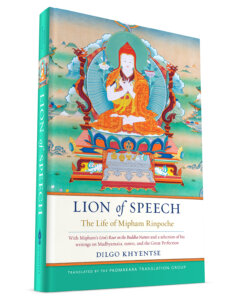
$27.95 - Hardcover
Jamgön Mipham (1846–1912) is one of the great luminaries of Tibetan Buddhism in modern times. He has had a dominant and vitalizing influence on the Nyingma school in particular and, despite spending most of his life in retreat, is one of Tibet’s most prolific authors.
The first half of this volume comprises the first-ever English translation of the biography of Mipham Rinpoche written by Dilgo Khyentse Rinpoche.
In keeping with the identification of Mipham as an emanation of Manjushri, the lion of speech, the second half comprises a selection of Mipham’s writings, designed to give the reader an experience of Mipham’s eloquent speech and incisive thought. It includes both a new translation of The Lion’s Roar: A Comprehensive Discourse on the Buddha-Nature and A Lamp to Dispel the Dark, a teaching of the Great Perfection, as well as excerpts from previously published translations of his works on Madhyamaka and tantra.
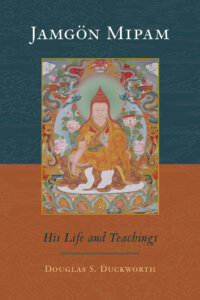
$34.95 - Paperback
Jamgön Mipam (1846–1912) is one of the most extraordinary figures in the history of Tibet. Monk, mystic, and brilliant philosopher, he shaped the trajectory of Tibetan Buddhism’s Nyingma school. This introduction provides a most concise entrée to this great luminary’s life and work. The first section gives a general context for understanding this remarkable individual who, though he spent the greater part of his life in solitary retreat, became one of the greatest scholars of his age. Part Two gives an overview of Mipam’s interpretation of Buddhism, examining his major themes, and devoting particular attention to his articulation of the Buddhist conception of emptiness. Part Three presents a representative sampling of Mipam’s writings.
Madhyamaka, or the Middle Way, is founded on the idea that all phenomena are empty of an inherent, unchanging, and permanent ‘nature.’ Nagarjuna, believed to be the first proponent of Madhyamaka, identified two aspects of truth: the relative, being the functional aspect of the phenomenal world, and the ultimate, which is beyond conventions and mental elaboration.
$32.95 - Paperback
Introduction to the Middle Way presents an adventure into the heart of Buddhist wisdom through the Madhyamika, or "middle way," teachings, which are designed to take the ordinary intellect to the limit of its powers and then show that there is more.
This book includes a verse translation of the Madhyamakavatara by the renowned seventh-century Indian master Chandrakirti, an extremely influential text of Mahayana Buddhism, followed by an exhaustive logical explanation of its meaning by the modern Tibetan master Jamgön Mipham, composed approximately twelve centuries later. Chandrakirti's work is an introduction to the Madhyamika teachings of Nagarjuna, which are themselves a systematization of the Prajnaparamita, or "Perfection of Wisdom" literature, the sutras on the crucial but elusive concept of emptiness.
$39.95 - Paperback
In the Madhyamakalankara, Shantarakshita synthesized the views of Madhyamaka and Yogachara, the two great streams of Mahayana Buddhism. This was the last great philosophical development of Buddhist India.
In his brilliant and searching commentary, Mipham re-presented Shantarakshita to a world that had largely forgotten him, defending his position and showing how it should be understood in relation to the teaching of Chandrakirti. To do this, he subtly reassessed the Svatantrika-Prasangika distinction, thereby clarifying and rehabilitating Yogachara-Madhyamaka as a bridge whereby the highest philosophical view on the sutra level flows naturally into the view of tantra. Mipham’s commentary has with reason been described as one of the most profound examinations of Madhyamaka ever written.
$29.95 - Paperback
$39.95 - Hardcover
Shāntideva’s guide to the training of a Bodhisattva is one of the most important and beloved texts in the Tibetan tradition. The ninth chapter, however, dealing with Madhyamaka, the Middle Way, the most profound wisdom view of Mahayana Buddhism, has always posed unique challenges to readers. This commentary by the great scholar Mipham Rinpoche presents in quite straightforward terms Shantideva’s exposition of emptiness, the essential foundation of all Buddhist doctrine, demonstrating that it is not only compatible with, but in fact crucial to, the correct understanding of other important Buddhist teachings such as karma, rebirth, and the practice of compassion. Mipham interprets Shāntideva according to the view of the Nyingma school, which in some respects was at variance with the religiously and politically dominant interpretation of the text in Tibet at that time. As a result, his commentary stirred up a furious debate. With the addition of a critique of Mipham Rinpoche’s view by a prominent scholar of the time, along with Mipham’s response, that debate is beautifully captured in this volume.
These works are part of a collection known as the Five Maitreya Teachings, a set of philosophical works that have become classics of the Indian Buddhist tradition. Maitreya, the Buddha’s regent, is held to have entrusted these profound and vast instructions to the master Asaṅga in the heavenly realm of Tuṣita.
$22.95 - Paperback
Middle Beyond Extremes contains a translation of the Buddhist masterpiece Distinguishing the Middle from Extremes. This famed text, often referred to by its Sanskrit title, Madhyantavibhaga, is part of a collection known as the Five Maitreya Teachings. Maitreya is held to have entrusted these profound and vast instructions to the master Asanga in the heavenly realm of Tusita.
Distinguishing the Middle from Extremes employs the principle of the three natures to explain the way things seem to be as well as the way they actually are. It is presented here alongside commentaries by two outstanding masters of Tibet’s nonsectarian Rimé movement, Khenpo Shenga and Ju Mipham.
$18.95 - Paperback
The Buddhist masterpiece Distinguishing Phenomena from Their Intrinsic Nature, often referred to by its Sanskrit title, Dharmadharmatāvibhanga, is part of a collection known as the Five Maitreya Teachings, a set of philosophical works that have become classics of the Indian Buddhist tradition. Maitreya, the Buddha's regent, is held to have entrusted these profound and vast instructions to the master Asanga in the heavenly realm of Tusita. By divesting the mind of confusion, the treatise explains, we see things as they actually are. This insight allows for the natural unfolding of compassion and wisdom. This volume includes commentaries by Khenpo Shenga and Ju Mipham, whose discussions illuminate the subtleties of the root text and provide valuable insight into the nature of reality and the process of awakening.
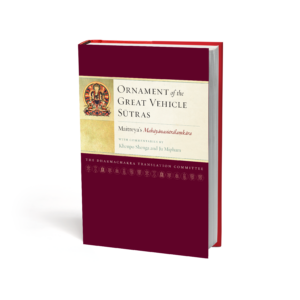
$69.95 - Hardcover
The Buddhist masterpiece Ornament of the Great Vehicle Sūtras, often referred to by its Sanskrit title, Mahāyānasūtrālaṃkāra, is part of a collection known as the Five Maitreya Teachings, a set of philosophical works that have become classics of the Indian Buddhist tradition. Maitreya, the Buddha’s regent, is held to have entrusted these profound and vast instructions to the master Asaṅga in the heavenly realm of Tuṣita.
The Ornament provides a comprehensive description of the bodhisattva’s view, meditation, and enlightened activities. Bodhisattvas are beings who, out of vast love for all sentient beings, have dedicated themselves to the task of becoming fully awakened buddhas, capable of helping all beings in innumerable and vast ways to become enlightened themselves. To fully awaken requires practicing great generosity, patience, energy, discipline, concentration, and wisdom, and Maitreya’s text explains what these enlightened qualities are and how to develop them.
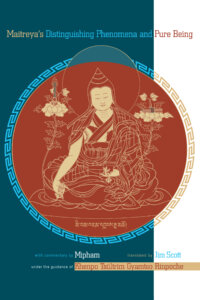
$24.95 - Paperback
Distinguishing Phenomena and Pure Being was composed by Maitreya during the golden age of Indian Buddhism. Mipham's commentary supports Maitreya's text in a detailed analysis of how ordinary, confused consciousness can be transformed into wisdom. Easy-to-follow instructions guide the reader through the profound meditation that gradually brings about this transformation. This important and comprehensive work belongs on the bookshelf of any serious Buddhist practitioner—and indeed of anyone interested in realizing their full potential as a human being.
Listen to Dzongsar Khyentse Rinpoche teach on the Ornament of the Mahayana Sutras
Stephen Gethin from the Padmakara Translation Group discusses his translation of A Feast of the Nectar of the Supreme Vehicle, Mipham RInpoche's commentary on the Ornament of the Great Vehicle Sutras Mahayanasutralamkara.
$69.95 - Hardcover
A monumental work and Indian Buddhist classic, the Ornament of the Mahāyāna Sūtras (Mahāyānasūtrālamkāra) is a precious resource for students wishing to study in-depth the philosophy and path of Mahāyāna Buddhism. This full translation and commentary outlines the importance of Mahāyāna, the centrality of bodhicitta or the mind of awakening, the path of becoming a bodhisattva, and how one can save beings from suffering through skillful means.
An interview with Sangye Khandro and Lama Chonam on the creation and relevance of this landmark translation of The Epic of Gesar.
The epic of Gesar has been the national treasure of Tibet for almost a thousand years. An open canon of tales about a superhuman warrior-king, the epic is still a living oral tradition, included on UNESCO’s Representative List of the Intangible Cultural Heritage of Humanity. This book is a translation of the beginning portion of this enormous corpus that Mipham Rinpoche compiled.
Born in the pure lands the son of two wisdom deities, Gesar takes rebirth in the human realm in order to defeat the demon kings who had taken over the empires of Asia and to thus liberate the people from suffering. His jealous uncle Trothung proves to be the first major threat to this goal, but Gesar outwits him every time using magic. In the last chapters of the book, he and Trothung’s son face off in a high-tension horse race to decide who will win the throne of Ling and the hand of the coveted Princess Drugmo in marriage.
Gesar’s story is popularly read as an allegory, with Gesar representing the ideal of spiritual warriorship—that is, fearlessness in the face of obstacles on the path to enlightenment. Just as Gesar rides his flying steed, we too can ride the energy of our inherent dignity, confidence, and strength, subduing inner demons and claiming victory.
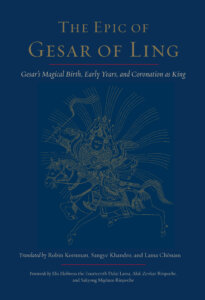
Born in the pure lands the son of two wisdom deities, Gesar takes rebirth in the human realm in order to defeat the demon kings who had taken over the empires of Asia and to thus liberate the people from suffering. His jealous uncle Trothung proves to be the first major threat to this goal, but Gesar outwits him every time using magic. In the last chapters of the book, he and Trothung’s son face off in a high-tension horse race to decide who will win the throne of Ling and the hand of the coveted Princess Drugmo in marriage.
$39.95 - Paperback
This volume recounts stories of Gesar fending off demons and liberating his foes as an enlightened leader. While the first three volumes cover Gesar’s birth, youth, and rise to power, this volume recounts the martial victories and magical feats that made him a legendary figure in Tibet and beyond.
A Garland of Views presents both a concise commentary by the eighth-century Indian Buddhist master Padmasambhava on a chapter from the Guhyagarbha Tantra on the different Buddhist and non-Buddhist philosophical views, including the Great Perfection (Dzogchen), and an explicative commentary on Padmasambhava’s text by the nineteenth-century scholar Jamgön Mipham (1846–1912).
Padmasambhava’s text is a core text of the Nyingma tradition because it provides the basis for the system of nine vehicles (three sutra vehicles and six tantra vehicles) that subsequently became the accepted way of classifying the different Buddhist paths in the Nyingma tradition.
Mipham’s commentary is the one most commonly used to explain Padmasambhava’s teaching. Mipham is well known for his prolific, lucid, and original writings on many subjects, including science, medicine, and philosophy, in addition to Tibetan Buddhist practice and theory.
$24.95 - Paperback
Leadership. Power. Responsibility. From Sun Tzu to Plato to Machiavelli, sages east and west have advised kings and rulers on how to lead. Their motivations and techniques have varied, but one thing they have in common is that the relevance of their advice has reached far beyond the few individuals to whom they were originally addressing. Over the centuries, millions have read their works and continue to be inspired by their teachings.
The nineteenth-century Buddhist monk and luminary Jamgön Mipham’s letter to the king of Dergé, whose small kingdom straddled China and Tibet during a particularly turbulent period, is similar in the universality of its message. This work, however, is unique in that it stresses compassion, impartiality, self-control, and virtue as essential for long-lasting success—whether as a leader or an individual trying to live a meaningful life. Mipham’s historic contribution to ethics and governance, until now little studied outside of Buddhist circles, teaches us the importance of protecting life, implementing fair taxation, supporting environmental sustainability, aiding the poor, and safeguarding freedom of religion. Both present-day leaders and those they lead will find this classic work, finally available in English, profoundly illuminating on political, societal, and personal levels.
$24.95 - Paperback
The Tibetan divination system called "Mo" has been relied upon for centuries to give insight into the future turns of events, undertakings, and relationships. It is a clear and simple method involving two rolls of a die to reveal one of the thirty-six possible outcomes described in the text. This Mo, which obtains its power from Manjushri, was developed by the great master Jamgön Mipham from sacred texts expounded by the Buddha.
Mipham Rinpoche's Beacon of Certainty, a very important text used by Nyingma monastic colleges, includes an in-depth treatment of Madhyamaka, tantra, and Dzogchen.
He also wrote a song expressing the view of Dzogchen which Thrangu Rinpoche uses to illustrate the unitty of the paprroaches of Dzogchen, Mahamudra and Madhyamaka in Harmony of Views: Three Songs by Ju Mipham, Changkya Rolpay Dorje, and Chögyam Trungpa.
Fundamental Mind , which also includes a sixteen-page biography of Mipham Rinpoche by Khetsun Sangpo Rinpoche, consists of the first volume of his trilogy called the Three Cycles of Fundamental Mind, a Nyingma text on ultimate reality that emphasizes the introduction of fundamental mind through a lama's instructions.
There are also a few selections contained in other books, including In Praise of Dharmadhatu by Nagarjuna with commentary by the Third Karmapa, Rangjung Dorje. This book contains a few selections by Mipham Rinpoche. In the first, from his Exposition of the Madhyamakalamkara, he emphasizes the critical importance of directly connecting with the experience of Dzogchen by first gaining certainty in primordial purity-otherwise one ends up with a view that will get one nowhere.
In Straight from the Heart there is a short teaching which is a pith instruction on Mahamudra
In Dream Yoga and the Practice of Natural Light, Chapter 10 consists of a short Dzogchen text by Mipham Rinpoche on the nature of mind entitled The Quintessential Instructions of Mind: The Buddha No Farther Than One's Palm.
$21.95 - Paperback
$18.95 - Paperback
$29.95 - Paperback
$49.95 - Paperback
Dream Yoga and the Practice of Natural Light
$19.95 - Paperback
Mipham Rinpoche's work on Tantra is also very extensive. His main work in English is his commentary on the Guhyagarbha Tantra, which is the essence of the eighteen Mahayoga tantras. There are two translations of this: The Essence of Clear Light, which includes the Tibetan, and Luminous Essence. For this text, it is really important that they be read by those who have received the initiation and have permission and guidance from a qualified teacher specifically for this text. By all accounts, there is no point to read these without having completed the proper preparation.
In White Lotus: An Explanation of the Seven-Line Prayer to Guru Padmasambhava, he gives a detailed explanation of this foundational prayer, explaining to us how to understand it according to its many layers of meaning.
$95.00 - Hardcover
$34.95 - Hardcover
$18.95 - Paperback
Two other works include wonderful pieces by Mipham Rinpoche that we should mention. As mentioned above, he really reinvigorated the Nyingma tradition during a time when there were many critics who did not properly understand it. The Ri-me Philosophy of Jamgon Kongtrul the Great: A Study of the Buddhist Lineages of Tibet includes a scathing eight-page rebuttal of critics of the Nyingma tantras.
A short but extremely moving prayer by Mipham Rinpoche in praise to Yeshe Tsogyal called The Longing Melody on Faith is included in Thinley Norbu Rinpoche's masterpiece on ngondro, or the preliminary practices, A Cascading Waterfall of Nectar.
Mipham Rinpoche also wrote a short text on the Treasure tradition entitled The Gem that Clears the Waters: An Investigation of Treasure Revealers, in which he presents a funny, honest look at the terma tradition. This is included in Tibetan Treasure Literature.
$29.95 - Paperback
The Ri-me Philosophy of Jamgon Kongtrul the Great
$24.95 - Paperback
A Cascading Waterfall of Nectar
$28.95 - Paperback
Mipham Rinpoche is central to the curriculum at the vast Buddhist community of Larung Gar, founded by His Holiness Jigme Phuntsok Rinpoche. It is therefore no surprise to find Mipham RInpoche's work throughout the 2021 release of Voices from Larung Gar: Shaping Tibetan Buddhism for the Twenty-First Century. In particular, there is a translation of Mipham Rinpoche's Wangdu, Great Clouds of Blessings: The Prayer That Magnetizes All that Appears and All That Exists. This is a practice that is credited for making Larung Gar the important center that it remains to this day. Khenpo Sodargye provides a detailed explanation of this magnetizing practice over thirty pages, the benefits of which he describes as follows:
"By relying on the prayer, one gains, in the outer sense, the ability to benefit all living beings, while its inner effect offers one the ability to control discursive thoughts and thereby attain full control of the body and the mind."
$24.95 - Paperback
In Ruby Rosary, Kyabje Thinley Norbu Rinpoche quotes Mipham Rinpoche at length - over eight pages, describing the life and impact of Rongzom Chokyi Zangpo (Rongzom Mahapandita).
"The teachings of the Early Translation school constituted the principal practice of the Great Rongzom. In particular, all the Secret Mantra teachings of the Early Translation school—the instructions given by Padmasambhava, Vimalamitra, Vairotsana, and others—were contained within and transmitted to Rongzompa. His main practice was the Nyingma teachings. He mastered the approach and accomplishment of Mātaraḥ, Yamarāja, and Vajrakīla, and with this power he subjugated all the gods and demons of the eight classes throughout Tibet, who offered him their life essence."
$39.95 - Hardcover
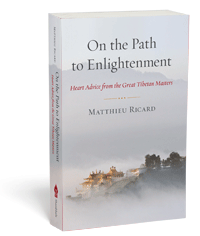 There are many other books where Mipham Rinpoche's work and influence is discussed.
There are many other books where Mipham Rinpoche's work and influence is discussed.
Tibetan Literature: Studies in Genre refers to his contributions to the Gesar epic, his book on how to prepare colors, ink, and gold for thangka painting, as well as his vast contributions to philosophical literature.
The recently released anthology by Matthieu Richard, On the Path to Enlightenment, has four short pieces by Mipham Rinpoche.
The Buddhist Psychology of Awakening (to be published in 2019 by Shambhala) also contains an evaluation of his contribution to the understanding of Abhidharma.
$39.95 - Paperback
In his remarkable book Incarnation, Tulku Thondop Rinpoche says:
This great scholar and adept said, at the time of his passing, "After this life, I will never take rebirth in this mundane world. I will remain only in pure lands. However, because of the power of aspirations, it is natural that the display of my tulkus as the Noble Ones will appear as long as samsara remains. " When people urged him to live longer, he said, "I certainly will not live. I will not take rebirth either. I am going to Shambhala in the North. "
But his legacy is very much with us today, directly through his teachings and the many masters who continue to pass them on in the East and West.
In Brilliant Moon, Dilgo Khyentse Rinpoche, who was one of the most influential teachers of our generation, talks about Mipham Rinpoche throughout, with over 170 references to him.
It is no surprise that Mipham Rinpoche's teachings continue to appear in the written and oral teachings of many contemporary teachers. As one example in many, Khenpo Garwang's recently released Your Mind Is Your Teacher is a detailed instruction on contemplative or analytical meditation based on Mipham Rinpoche's Wheel of Analytical Meditation.
We look forward to seeing more and more of Mipham Rinpoche's material to be published in English in the coming years.
Check out more reader guides on Tibetan Buddhism!


